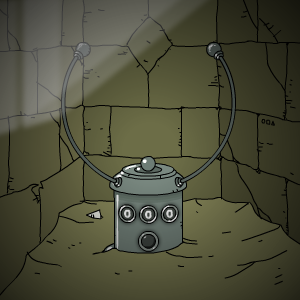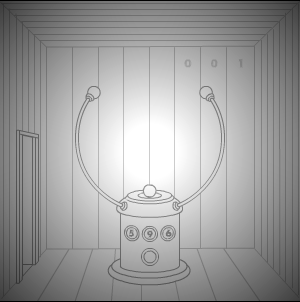Hey folks, what's good!
In the previous episode we talked about a puzzle/exploration game released not too long ago called Kairo. I highly recommend you to read the previous entries in order to give yourself a better idea of what all the fuss is about, and why all of a sudden I'm so eager to talk about exploration games.
This part is dedicated to not just a single game but rather an entire series of experiences. Experiences that the Newgrounds community has also stumbled upon at least once in the past since these games have been originally hosted on this very website back in the good old days. This time we take a look at the element of exploration from another point of view. A perspective that is part alienating, part protagonist.
I'm sure at least a good handful of people here are familiar with the so called "point and click" adventure games. You don't often have an on-screen character to lead, the scenarios are still backgrounds that act as the main scene of the game, and every action can be performed by a single mouse click. Such strain of adventure games has quite a glorious history spanning several decades, spawning directly from '70s and '80s text-based adventure games as soon as the first graphics were introduced in the mainstream.

I could digress and fill entire pages with their history, but that's another story for another time and place. The concept of a point and click game is in my opinion intriguing because it often provides a distinctive aura of mystery as soon as the first screens are introduced to the player. Recent developments of the genre have pushed the envelope even further by giving such concepts a more stripped down, straightforward formula. You would often stumble on short games that have no plot - if not just a very basic premise as an excuse plot, no dialogue, just you stuck in a room and the lock and key puzzles preventing you to breach the exit.
"Escape the room" games have been a trend in recent years and still hold a certain degree of popularity among aficionados, even having entire websites such as this one wholly devoted to this niche. Worth of note, Nine Hours, Nine Persons, Nine Doors for Nintendo DS, and from Newgrounds, gems such as the Alice is Dead trilogy by @Hyptosis, An Escape Series by @Afro-Ninja, and the Cube Escape series by @RustyLake definitely deserve their own share of praise. These are just examples of course, Newgrounds itself is filled with similar experiences that I heartily suggest to try out yourself or mention in the comment section below.
The tediously long introduction actually served not as a crescendo to an ever-growing spiral of ramblings, but actually as a preparation to the surprisingly complex work of fiction that I am privileged to analyze with you all without giving away any potential spoiler. A complexity that lies within the disarming simplicity of its main premise. A hidden universe, or perhaps many -verses buried deep beneath the vastness of the largely unexplored network. Welcome to the Submachine.

The Submachine series, born from the twisted neurons of @Mateusz-Skutnik, is quite a peculiar case of a point and click game gone mad by the revelation. We could say it is experimental in nature, in that from its conception of nearly a decade ago, the series has matured into something far more sinister and desolating than the innocent, standard escape the room premise a random mook like myself would be fairly accustomed to after a couple of similar try-outs.
Indeed, back in 2005 when the first Submachine chapter came out, the formula was quite basic. Something we've already seen around. No recollection of the past or of your current whereabouts, you are thrown straight into the action inside what seems to be some really dated machine with conveniently placed puzzles protecting strange anachronistic artifacts. It surely makes sense in context, right? It was a pretty short experience overall. Nothing really that groundbreaking, but still enjoyable. Enter the second chapter however, and things start to get interesting...

Starting from the second chapter, the mastermind behind the series makes sure to add a little something that gradually deconstructs the unspoken rules of what constitutes an escape the room game. In each chapter we see how the series matures into a universe that really comes up with its own rules rather than strictly following an already established archetype. Every added element brings a whole new level of mystery in an already vague, we could say surreal setting. So in what way does exploration play an important role in this series, and why?
I think the heart of the series doesn't really rest on the vague plot whose bits and pieces found here and there never really seem to give anything explicitly, but it's the game atmosphere that creates this mystical, intriguing aura. Artsy hand drawn scenarios aside, the fact that all chapters seem to be so incredibly desolate, that this submerged network looks like an intricate, chaotic junkyard of machinery from different eras powered by an unknown source and surrounded by nothing but a pitch black void, makes this whole journey not just a puzzle-driven chore but more like a personal search for the greater truth behind the Submachine universe.

It is, in fact, a more psychological take on the usual escape the room type of experience. The sound department is as minimal as it can possibly be. Some creepy drone played every once in a while helps setting the dark, desolate atmosphere of the world outside the game scenarios — in other words, complete blackness. I'm sure some of you might regard the series as a horror series despite the fact that it really isn't. The series per se does a good job at inferring rather than showing. It's heavily implied that something has happened but we don't really know what nor by whom.
The main element that triggered the genie of curiosity in me was not even the atmosphere. It is rather the daunting presentation of a virtually infinite set of Submachine rooms, each with their own puzzles to solve and increasingly mind-bending geometries that take full advantage of the 2D interface. This concept is further expanded in one spinoff chapter called Submachine Universe, where the goal of the experience is to encourage players to explore the incredibly vast network of rooms and make up their own individual theories.

It is ultimately an experience for a community of explorers that share a common thirst for knowledge and a passion for virtual archeology. It is no longer about the individual player grabbing pen and paper to solve yet another lock and key puzzle. It is a wider effort, where you are an element of a greater ensemble. The community itself expands the original concept by bringing a lot of interesting ideas to the table, where everything is relative to our own individual perception, and nothing is entirely certain. A metaphor for our real life universe? Maybe. I call it smart design.
The series creator only needed a context to create a fictional set of rules for everyone else to explore and complement with their own experiences. It is, in a sense, a feedback experience. Exploration in this series is not just a gameplay element tidally locked to the traditional lock and key mechanics of the puzzles, but it is pivotal in trying to understand the background of such an open-ended setting. The more questions you answer, the more questions arise at an ever expanding rate, I'd even dare say exponentially.

This is, in a nutshell, what makes Submachine a fascinating piece of work. The series might formally end with the upcoming 10th chapter, but it is never really over. There's still a lot more to explore, to unveil, to analyze, to theorize. It truly ends only with your attention switching to something else.
Stay tuned, folks.